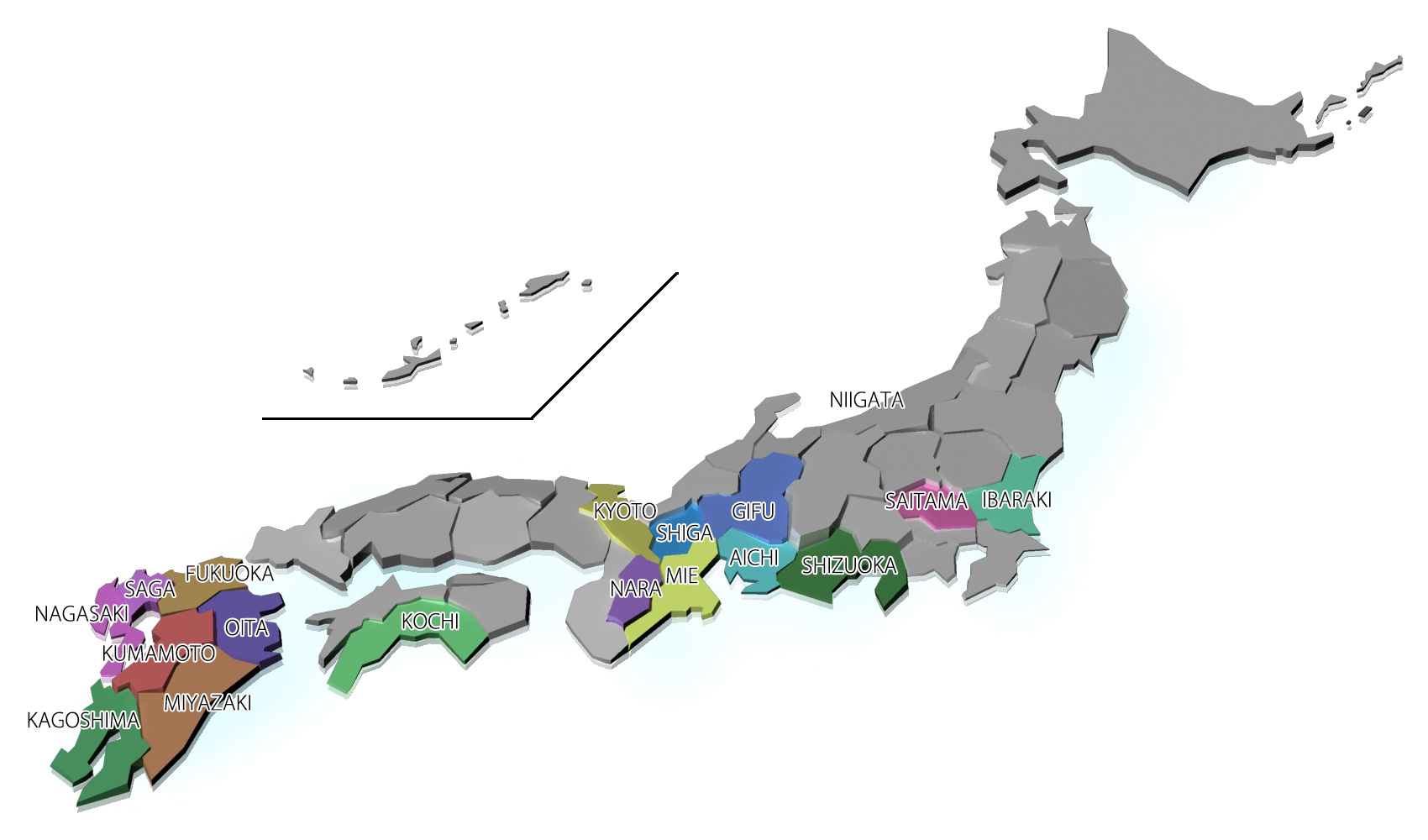Production areas
While tea is produced just about everywhere in Japan, production is nonetheless very limited in the northernmost parts of Japan.

Surface cultivated (in hectares) per prefecture in 2022
| Prefecture | Surface cultivated (ha) | Ratio(%) | |
| 1 | SHIZUOKA | 13,800 | 39.14 |
| 2 | KAGOSHIMA | 8,250 | 23.40 |
| 3 | MIE | 2,552 | 7.24 |
| 4 | KYOTO | 1,528 | 4.33 |
| 5 | FUKUOKA | 1,488 | 4.22 |
| 6 | MIYAZAKI | 1,230 | 3.49 |
| 7 | KUMAMOTO | 1,100 | 3.12 |
| 8 | SAITAMA | 785 | 2.23 |
| 9 | NAGASAKI | 680 | 1.93 |
| 10 | SAGA | 576 | 1.63 |
| 11 | NARA | 488 | 1.38 |
| 12 | OITA | 486 | 1.38 |
| 13 | GIFU | 398 | 1.13 |
| 14 | SHIGA | 383 | 1.09 |
| 15 | AICHI | 278.2 | 0.79 |
| 16 | IBARAKI | 174 | 0.49 |
| 17 | KOCHI | 136.2 | 0.39 |
| Other | 924.6 | 2.62 | |
| Total | 35,257 | 100 |
Production of aracha raw tea (in tons) per prefecture in 2022
| Prefecture | Production of aracha raw tea (t) | Ratio(%) | |
| 1 | SHIZUOKA | 28,600 | 38.05 |
| 2 | KAGOSHIMA | 26,700 | 35.52 |
| 3 | MIE | 5,316 | 7.07 |
| 4 | KYOTO | 2,645 | 3.52 |
| 5 | MIYAZAKI | 2,304 | 3.07 |
| 6 | NARA | 1,755 | 2.33 |
| 7 | FUKUOKA | 1,365 | 1.82 |
| 8 | SAGA | 1,191 | 1.58 |
| 9 | KUMAMOTO | 974 | 1.30 |
| 10 | SAITAMA | 790 | 1.05 |
| 11 | OITA | 673 | 0.90 |
| 12 | NAGASAKI | 642 | 0.85 |
| 13 | AICHI | 559 | 0.74 |
| 14 | SHIGA | 494 | 0.66 |
| 15 | IBARAKI | 228 | 0.3 |
| 16 | KOCHI | 160 | 0.21 |
| 17 | GIFU | 151 | 0.2 |
| Other | 616 | 0.38 | |
| Total | 75,163 | 100 |
For a long time, Shizuoka Prefecture has by far been the most significant tea production region in Japan. But, in recent years, the production of the region has decreased and Kagoshima has managed to catch up. These two prefectures, Shizuoka and Kagoshima, represent nearly three quarters of the tea production in Japan.
While Mie’s output is certainly less than Shizuoka or Kagoshima, Mie is the third-largest production region in Japan. However, tea from Mie—sometimes called Ise-cha—are not well known in Japan. Ise-cha is generally used in blends. In contrast, it is not an exaggeration to say that teas from Kyôto—also called teas from Uji—are the best-known tea from Japan, as much inside as outside the country. Despite this, Kyôto is in fourth place in terms of production and represents only 4% of the total production in Japan. Teas from Mie, Shiga, and even Nara are also sometimes used as part of the blends used to make “Uji tea.”
The southern island of Kyûshû Island is also a very active area for tea thanks to not only the region of Kagoshima, but also Fukuoka, Miyazaki, Kumamoto, Saga, Nagasaki and Oita.
North of Tôkyô, we have Saitama Prefecture, the famous production region of that is known for Sayama tea. While the quantity of tea produced in Saitama is relatively limited, Saitama is a varied and dynamic production region. Less well known than Saitama, we also the Sashima and Okukuji have production regions in Ibaraki Prefecture, to the north-east of Tôkyô.
We should also mention the northernmost production region for commercial tea, Murakami in Niigata Prefecture, on the coast of the Sea of Japan.
Sencha is produced everywhere, but there are trends in the teas that come out of different regions. Kyûshû tends to produce shaded, fukamushi senchas. While Kyôto also makes shaded teas, but they are usually futsumushis (standard steamed teas). With its lowland fukamushis and mountain futsumushis, Shizuoka leans towards unshaded teas. The biggest gyokuro production regions are Kyôto, Yame (Fukuoka), and—to a lesser extent—Asahina (Shizuoka). For the most part, high-end matcha comes from Kyôto and low-end matcha comes from Aichi. Tamaryokuchas and Kama-iri chas are produced in Kyûshû.
Finally, the figures show that size of the area covered by tea crops and the quantity of tea that come out of those crops do not always match. This might explain, in part, why some regions tend to have fewer harvests.
